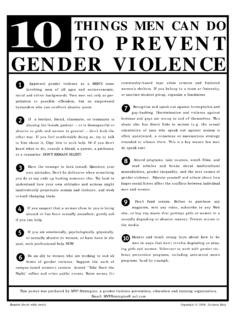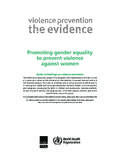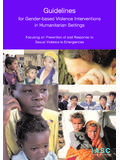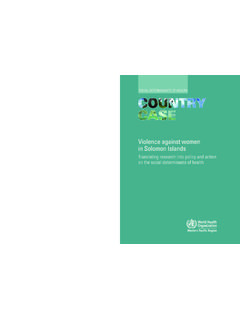Transcription of Sexual and Gender-Based Violence against Refugees ...
1 UNITED NATIONS HIGH COMMISSIONER FOR Refugees Sexual and Gender-Based Violence against Refugees , returnees and internally Displaced Persons Guidelines for Prevention and Response May 2003. UNITED NATIONS. HIGH COMMISSIONER. FOR Refugees . United Nations High Commissioner for Refugees , 2003. This document is issued for general distribution. All rights are reserved. This document may be freely reproduced and translated, in part or in whole (except for commercial purposes) provided UNHCR is acknowledged. Sexual and Gender-Based Violence against Refugees , returnees and internally Displaced Persons Guidelines for Prevention and Response May 2003. UNITED NATIONS. HIGH COMMISSIONER. FOR Refugees . TABLE OF CONTENTS. Foreword .. 1. Introduction .. 3. Chapter 1: Overview of Sexual and Gender-Based Violence .. 7. Protecting Refugees against Sexual and Gender-Based Violence .. 8. What is Sexual and Gender-Based Violence ?
2 10. Defining Key Concepts.. 11. Types of Sexual and Gender-Based Violence .. 15. When and Where does Sexual and Gender-Based Violence Occur? .. 19. Causes and Consequences of Sexual and Gender-Based Violence .. 21. Key Points to Remember .. 25. Chapter 2: Guiding Principles .. 27. Programme Guiding Principles .. 28. Individual Guiding Principles .. 29. Multi-Sectoral Approach .. 31. Key Points to Remember .. 32. Chapter 3: Preventing Sexual and Gender-Based Violence .. 33. Transforming Socio-Cultural Norms .. 35. Rebuilding Family and Community Support Systems .. 40. Creating Conditions to Improve Accountability Systems .. 41. Designing Effective Services and Facilities .. 42. Influencing the Formal and Informal Legal Framework .. 47. Monitoring and Documenting Incidents of Sexual and Gender-Based Violence .. 50. Key Points to Remember .. 51. i Sexual and Gender-Based Violence against Refugees , returnees and internally Displaced Persons Chapter 4: Responding to Sexual and Gender-Based Violence .
3 53. Developing Community Education and Awareness Activities .. 55. Training Actors in How to Respond to the Needs of Victims/Survivors .. 55. Establishing Referral, Reporting, Monitoring and Evaluation Mechanisms .. 56. Empowering Refugee Communities to Respond .. 58. Developing a Response to the Health/Medical Needs of Victims/Survivors .. 59. Planning to Meet the Psycho-Social Needs of Victims/Survivors.. 60. Developing a Security and Safety Response .. 61. Establishing a Legal/Justice Response .. 62. Identifying the Roles of Other Potential Actors .. 65. Developing a Plan for Working with Perpetrators .. 67. Key Points to Remember .. 68. Chapter 5: Special Considerations for Refugee Children .. 69. Guiding Principles.. 70. Groups of Refugee Children at Particular Risk of Sexual and Gender-Based Violence .. 71. Specific Forms of Sexual and Gender-Based Violence Used against Children .. 75. Special Considerations in Preventing Sexual and Gender-Based Violence against Children.
4 77. Special Considerations in Responding to Sexual and Gender-Based Violence against Children .. 80. Key Points to Remember .. 85. Chapter 6: Framework for Action .. 87. Developing an Action Plan .. 87. Key Points to Remember .. 96. ii Table of Contents Chapter 7: Monitoring and Evaluation .. 97. Defining Monitoring and Evaluation .. 97. Purposes of Monitoring and Evaluation Mechanisms .. 98. Types of Monitoring and Evaluation Mechanisms .. 99. Designing Monitoring and Evaluation Systems for Programmes Targeting Sexual and Gender-Based Violence .. 99. Sample Reporting Tools .. 103. Key Points to Remember .. 107. Chapter 8: gender -Related Persecution .. 109. gender -Related Persecution within the Context of Article 1A(2). of the 1951 Convention and/or its 1967. Protocol relating to the Status of Refugees .. 110. Appendix 1: UNHCR's Code of Conduct .. 123. Appendix : Core Principles of a Code of Conduct.
5 129. Appendix 2: Incident Report Form .. 131. Appendix 3: Monthly Sexual and Gender-Based Violence Report Form .. 143. Appendix 4: Health Examination Form .. 145. Suggested Resources .. 149. iii Sexual and Gender-Based Violence against Refugees , returnees and internally Displaced Persons Foreword FOREWORD. In every community in the world there are people who have been affected by acts of brutality. Atrocities committed by armed groups in conflict situations are often well publicized, while abuses committed behind closed doors in the confines of one's own home often remain completely hidden. Refugees and internally displaced people, who do not enjoy the protection of their own governments, are among those most vulnerable to acts of Violence , including Sexual and Gender-Based Violence . We have learnt that Sexual and Gender-Based Violence is most prevalent in environments where there is a general lack of respect for human rights.
6 Sexual and Gender-Based Violence is, of course, itself a human rights violation. Women and children, who are often most vulnerable to human rights abuses, are also the ones who suffer most from Sexual and Gender-Based Violence . These Guidelines offer practical advice on how to design strategies and carry out activities aimed at preventing and responding to Sexual and Gender-Based Violence . They also contain information on basic health, legal, security and human rights issues relevant to those strategies and activities. The Guidelines were developed in consultation with UNHCR's partners in refugee protection: governments, inter-governmental agencies and non-governmental organisations. They are intended for use by UNHCR. staff and members of operational partners involved in protection and assistance activities for Refugees and the internally displaced. They have been tested in 32 countries around the world with the participation of more than 60 partners.
7 Sexual and Gender-Based Violence is a serious problem, and one which we must tackle head-on. We have developed a number of tools to help to prevent it, and to assist survivors when we are unable to prevent it. It is up to all of us who work with Refugees and internally displaced people to use these tools effectively. Ruud Lubbers United Nations High Commissioner for Refugees 1. Sexual and Gender-Based Violence against Refugees , returnees and internally Displaced Persons 2. Introduction INTRODUCTION. Background UNHCR first published Sexual Violence against Refugees : Guidelines on Prevention and Response in 1995. By that time, it had become clear that the magnitude of the problem called for a focused approach and considered, concerted actions that had not, until then, been adequately formulated and compiled in any of UNHCR's earlier publications. The 1995 Guidelines helped create a greater awareness and understanding of this serious human rights violation and laid the foundations for developing programmes to prevent and respond to it.
8 Yet Sexual and Gender-Based Violence against Refugees , especially women and children, continues unabated. It has been exacerbated by unequal gender relations within communities of concern; it has been used as a weapon of war and as a means of exercising power; it has been both a cause of forced displacement and a terrible consequence of the breakdown of family and community structures that accompanies displacement. It has also been perpetrated by some of the very people who have been entrusted with the task of protecting Refugees and displaced persons. Since 1995, many lessons have been learned concerning individual, institutional and national responsibilities for implementing the Guidelines and for providing protection to uprooted persons. Throughout those years, UNHCR, other UN agencies, governmental and non-governmental organisations, Refugees , returnees and internally displaced persons have evaluated the programmes and activities suggested in the Guidelines in the context of complex emergency situations.
9 The culmination of this evaluation process was the Inter-Agency Lessons Learned Conference on Prevention and Response to Sexual and Gender-Based Violence in Refugee Situations, which was held in Geneva in March 2001. Participants at the Conference identified areas for improvement and highlighted the importance of revising the 1995 Guidelines to reflect progress made over the years and to refine an inter-agency, multi-sectoral approach to addressing Sexual and Gender-Based Violence against Refugees , returnees and internally displaced persons. Recommendations from the Conference included strengthening institutional commitment by developing a Code of Conduct for humanitarian workers; setting common minimum standards for addressing Sexual and Gender-Based Violence ; supporting the allocation and management of adequate funding and staff; and integrating a gender -equality perspective in institutional practices.
10 Participants emphasised the need to engage the refugee community in all stages of programme delivery: design, implementation, monitoring and evaluation. 3. Sexual and Gender-Based Violence against Refugees , returnees and internally Displaced Persons Following up on Conference recommendations, these new Guidelines for the Prevention of and Response to Sexual and Gender-Based Violence against Refugees , returnees and internally Displaced Persons were developed through inter-agency consultations. They have been field-tested in 32 countries around the world, involving the participation of more than 60 key operational partners. Purpose of the Guidelines These Guidelines are intended to be used by the staff of UNHCR, UN. agencies, inter-governmental and non-governmental organisations and host government agencies who provide protection and assistance to Refugees and persons of concern to UNHCR. They are also intended to guide activities initiated by refugee communities themselves to prevent and address the problem.
















